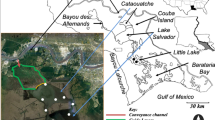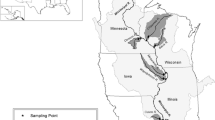Abstract
The Patuxent River, Maryland, is a nutrient-overenriched tributary of the Chesapeake Bay. Nutrient inputs from sewage outfalls and nonpoint sources (NPS) have grown substantially during the last four decades, and chlorophylla levels have increased markedly with concomitant reductions in water quality and dissolved oxygen concentrations. The Patuxent has gained national attention because it was one of the first river basins in the U.S. for which basin-wide nutrient control standards were developed. These included a reduction in NPS inputs and a limit on both nitrogen (N) and phosphorus (P) loadings in sewage discharges intended to return the river to 1950s conditions. Full implementation of point source controls occurred by 1994, but population growth and land-use changes continue to increase total nutrient loadings to the river. The present paper provides the perspectives of scientists who participated in studies of the Patuxent River and its estuary over the last three decades, and who interacted with policy makers as decisions were made to develop a dual nutrient control strategy. Although nutrient control measures have not yet resulted in dramatic increases in water quality, we believe that without them, more extensive declines in water quality would have occurred. Future reductions will have to come from more effective NPS controls since future point source loading will be difficult to further reduce with present technology. Changing land use will present a challenge to policy makers faced with sprawling population growth and accelerated deforestation.
Similar content being viewed by others
Literature Cited
Abbe, G. R., B. W. Albright, C. B. McCollough, C. F. Dungan, andS. J. Jordan. 2002. Environmental effects onPerkinsis marinus infection rates, growth and survival among dermo-disease-free juvenile oysters planted at three salinity regimes in Patuxent River, Maryland. Abstract of a technical paper presented at the 55th annual meeting National Shellfisheries Association and Pacific Coast Oyster Growers Association: Pacific Coast Section, Silverdale, Washington, September 20–22, 2001.Journal of Shellfish Research 21:371.
Boynton, W. R., J. H. Garber, R. Summers, andW. M. Kemp. 1995. Inputs, transformations, and transport of nitrogen and phosphorus in Chesapeake Bay and selected tributaries.Estuaries 18:285–314.
Boynton, W. R., W. M. Kemp, andC. G. Osborne. 1980. Nutrient fluxes across the sediment-water interface in the turbidity zone of a coastal plain estuary, p. 93–109.In V. Kennedy (ed.), Estuarine Perspectives. Academic Press, New York.
Brush, G. 1984a. Stratiographic evidence of eutrophication in an estuary.Water Resources Research 20:531–541.
Brush, G. 1984b. Patterns of recent sediment accumulation in Chesapeake Bay (Virginia-Maryland, U.S.A.) tributaries.Chemical Geology 44:227–242.
Chesapeake Research Consortium. 1977. Proceedings of the Bi-State conference on the Chesapeake Bay. CRC Publication No. 61. Chesapeake Research Consortium, Edgewater, Maryland.
Cronin, W. B. andD. W. Pritchard. 1975. Additional statistics on the dimensions of the Chesapeake Bay and its tributaries: Cross-section widths and segment volumes per meter depth. Special report 42. Chesapeake Bay Institute, The Johns Hopkins University, Baltimore, Maryland.
Culliton, T. J., M. A. Warren, T. R. Godspeed, D. R. Rewer, C. M. Blackwell, andJ. J. McDonough, III. 1990. 50 years of population change along the nation's coasts 1960–2010. Second report coastal trust series. Strategies Assessment Branch, National Oceanic and Atmospheric Administration, Rockville, Maryland.
D'Elia, C. F. andJ. G. Sanders. 1987. Scientists don't make management decisions (and why we wish that sometimes we did ...).Marine Pollution Bulletin 18:429–434.
D'Elia, C. F., L. W. Harding, Jr.,M. Leffler, andG. B. Mackiernan. 1992. The role and control of nutrients in Chesapeake Bay.Water Science and Technology 26:2635–2644.
D'Elia, C. F., J. G. Sanders, andW. R. Boynton. 1986. Nutrient enrichment studies in a coastal plain estuary: Phytoplankton growth in large-scale, continuous cultures.Canadian Journal of Fisheries and Aquatic Sciences 43:397–406.
Hagy, J. D., W. R. Boynton, andM. M. Weir. 1998. Estimating nitrogen and phosphorus loads for the Patuxent River, 1960–1977, p. 184–211.In W. R. Boynton and F. M. Rohland (eds.), Ecosystem Processes Component (EPC), Level 1 Report No. 15, Reference No. [UMCES]CBL 98-073a. University of Maryland Center for Environmental Science, Chesapeake Biological Laboratory, Solomons, Maryland.
Hagy, J. D., L. P. Sanford, andW. R. Boynton. 2000. Estimation of net physical transport and hydraulic residence times for a coastal plain estuary using box models.Estuaries 23:328–340.
Heinle, D. R., C. F. D'Elia, J. L. Taft, J. S. Wilson, M. Cole-Jones, A. B. Caplins, andL. E. Cronin. 1980. Historical review of water quality and climatic data from Chesapeake Bay with emphasis on effects of enrichment. Grant #R806189010. USEPA Chesapeake Bay Program Final Report. Publication No. 84. Chesapeake Research Consortium, Inc., Annapolis, Maryland.
Horton, T. 1993. Chesapeake Bay—Hanging in the balance.National Geographic 183:2–35.
HydroQual. 1981. Water quality analysis of the Patuxent River. Report to Maryland Office of Environmental Programs. Maryland Department of the Environment, Baltimore, Maryland.
Kahn, H. andG. S. Brush. 1994. Nutrient and metal accumulations in a fresh tidal marsh.Estuaries 17:345–360.
Langland, M. J., R. E. Edwards, L. A. Sprague, andS. E. Yochum. 2001. Summary of trends and status analysis for flow, nutrients, and sediments at selected nontidal sites, Chesapeake Bay basin, 1985–99. Open File Report 01-73. U.S. Geological Survey, New Cumberland, Pennsylvania.
Malone, T. C., W. R. Boynton, T. Horton, andJ. C. Stevenson. 1993. Nutrient loading to surface waters: Chesapeake Bay case study, p. 8–38.In M. F. Uman (ed.), Keeping Pace with Science and Engineering. National Academy Press, Washington, D.C.
Maryland Department of Natural Resources. 1989. Commercial Fisheries Statistics. Tidewater Ecosystem Assessment Division, Annapolis, Maryland.
Maryland Department of Natural Resources. 2001. Maryland Tributary Water Quality Monitoring Program. Tidewater Ecosystem Assessment Division. Annapolis, Maryland.
Maryland Office of Planning. 2001. Patuxent Watershed Land Use Data. Maryland Department of Planning. Baltimore, Maryland.
Nash, C. B. 1947. Environmental characteristics of a river estuary.Journal of Marine Research 6:147–174.
Newcombe, C. L. andH. F. Brust. 1940. Variations in the phosphorus content of estuarine waters of the Chesapeake Bay near Solomons.Journal of Marine Research 3:76–88.
Powers, A. E. 1986. Overview: Law: Protecting the Chesapeake Bay: Maryland's Critical Area Program.Environment 28:5.
Riedel, G. F., G. R. Abbe, andJ. G. Sanders. 1995. Silver and copper accumulation in two estuarine bivalves, the eastern oyster (Crassostrea virginica) and the hooked mussel (Ishadium recurvum) in the Patuxent River estuary.Estuaries 18: 445–455.
Roosenburg, W. H. 1969. Greening and copper accumulation in the American oyster,Crassostrea virginica in the vicinity of a stream electric generating system.Chesapeake Science 10:241–252.
Ryther, J. H. andW. M. Dunstan. 1972. Nitrogen, phosphorus and eutrophication in the coastal marine environment.Science 171:1008–1013.
Sanders, J. G., S. J. Cibik, C. F. D'Elia, andW. R. Boynton. 1987. Nutrient enrichment studies in a coastal plain estuary: Changes in phytoplankton species composition.Canadian Journal of Fisheries and Aquatic Sciences 44:83–90.
Stankelis, R. M., M. D. Naylor, andW. R. Boynton. 2003. Submerged aquatic vegetation in the mesohaline region of the Patuxent estuary: Past, present, and future status.Estuaries 26:186–195.
U.S. Environmental Protection Agency. 1986. Chesapeake Bay Program. Scientific and technical advisory committee. Nutrient control in the Chesapeake Bay. Annapolis, Maryland.
Voinov, A. 2001. Patuxent watershed land use data. Chesapeake Biological Laboratory, Solomons, Maryland.
Wiedeman, A. andA. Cosgrove. 1998. Chesapeake Bay water-shed model application and calculations of nutrient and sediment loading. Appendix F: Point source loadings. USEPA Chesapeake Bay Program. Annapolis, Maryland.
Year 2020 Panel Report. 1988. Population growth and development in the Chesapeake Bay Watershed to the year 2020. A Report to the Chesapeake Executive Council. Chesapeake Bay Commission, Annapolis, Maryland.
Source of Unpublished Materials
Hagy, J. personal communication. U.S. Environmental Protection Agency, National Health and Environmental Effects Research Laboratory, Gulf Ecology Division, 1 Sabine Island Drive, Gulf Breeze, Florida 32561.
Author information
Authors and Affiliations
Corresponding author
Additional information
This paper is dedicated to the memory of Dr. Donald R. Heinle who really started this investigation.
Rights and permissions
About this article
Cite this article
D'Elia, C.F., Boynton, W.R. & Sanders, J.G. A watershed perspective on nutrient enrichment, science, and policy in the Patuxent River, Maryland: 1960–2000. Estuaries 26, 171–185 (2003). https://doi.org/10.1007/BF02695960
Received:
Accepted:
Issue Date:
DOI: https://doi.org/10.1007/BF02695960




